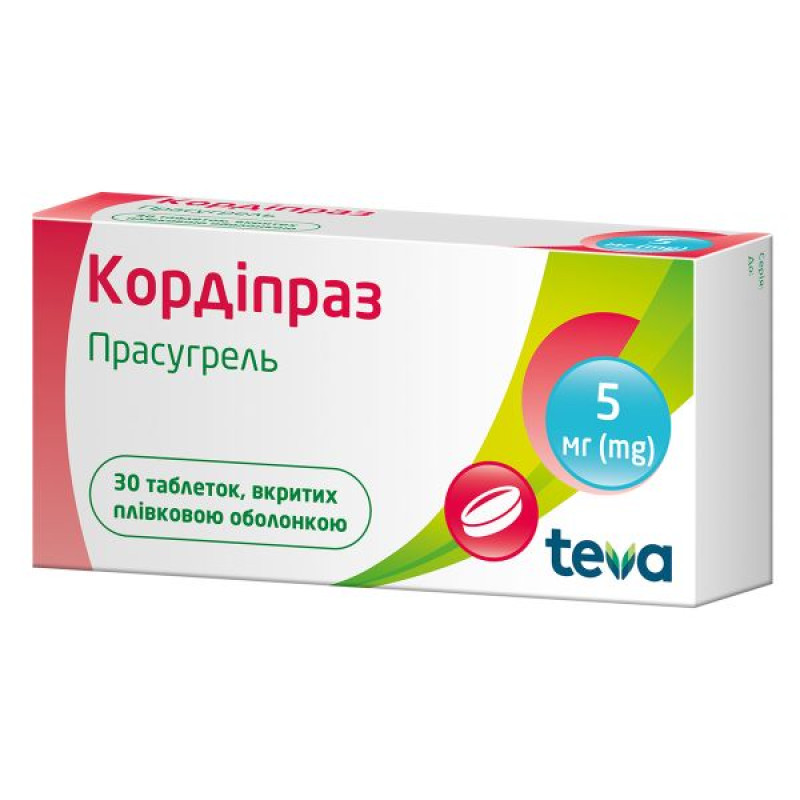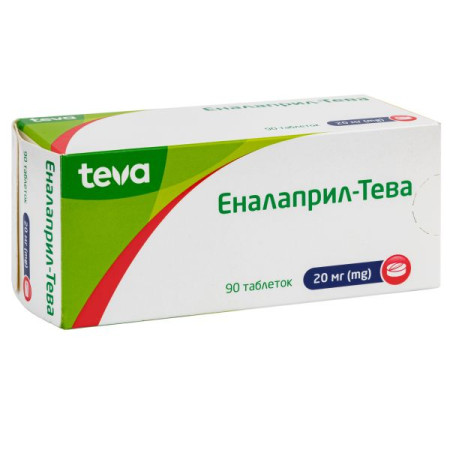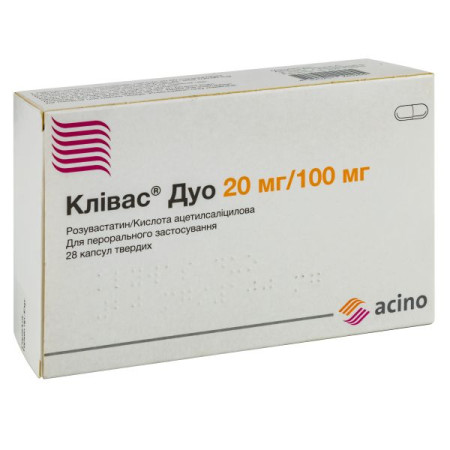Cordipraz film-coated tablets 5 mg blister No. 30

Composition
active ingredient: prasugrel;
1 film-coated tablet contains 5 mg prasugrel as prasugrel hydrobromide;
excipients: core: microcrystalline cellulose, mannitol (E 421), hypromellose, low-substituted hydroxypropylcellulose, glycerol dibehenate, sucrose stearate;
film coating for 5 mg tablets: partially hydrolyzed polyvinyl alcohol, titanium dioxide (E 171), polyethylene glycol 3350, talc, yellow iron oxide (E 172), red iron oxide (E 172), black iron oxide (E 172).
Release form
Film-coated tablets.
Pharmacological properties
Mechanism of action: Prasugrel is an inhibitor of platelet activation and aggregation by irreversible binding of its active metabolite to the P2Y 12 adenosine diphosphate (ADP) receptor on platelets. Since platelets are involved in the initiation and/or progression of thrombotic complications of atherosclerosis, inhibition of platelet function may reduce the incidence of cardiovascular events such as death, myocardial infarction, or stroke. After a loading dose of 60 mg of prasugrel, inhibition of ADP-induced platelet aggregation occurs within 15 minutes (5 μM ADP) and 30 minutes (20 μM ADP). The maximal inhibition of ADP-induced platelet aggregation by prasugrel was 83% (5 μM ADP) and 79% (20 μM ADP), with at least 50% inhibition of platelet aggregation achieved at 1 hour in both healthy subjects and patients with stable atherosclerosis. Prasugrel-mediated inhibition of platelet aggregation showed low inter-subject (9%) and intra-subject (12%) variability (both at 5 μM ADP and 20 μM ADP). The mean inhibition of platelet aggregation at steady state was 74% and 69% for 5 μM ADP and 20 μM ADP, respectively, and was achieved after 3-5 days of a 10 mg maintenance dose of prasugrel with a 60 mg loading dose. Over 98% of subjects had ≥20% inhibition of platelet aggregation at maintenance dosing. Platelet aggregation gradually returned to baseline values 7-9 days after a single 60 mg loading dose of prasugrel and 5 days after discontinuation of the maintenance dose at steady state.
Indication
Cordipraz in combination with acetylsalicylic acid is indicated for the prevention of atherothrombotic events in adult patients with acute coronary syndrome, i.e.:
- unstable angina (UA),
- non-ST-segment elevation myocardial infarction (NSTEMI) or
- ST-segment elevation myocardial infarction (STEMI),
who are undergoing primary or delayed percutaneous coronary intervention.
See also the section "Pharmacological properties".
Contraindication
Hypersensitivity to the active substance or to any of the excipients of the medicinal product.
Active pathological bleeding.
History of stroke or transient ischemic attack (TIA).
Severe hepatic impairment (Child-Pugh class C).
Application
Dosage
Adults: Prasugrel should be initiated with a single 60 mg loading dose, followed by 10 mg once daily. Patients with ACS/STEMI undergoing coronary angiography within 48 hours of admission should receive a loading dose only at the time of PCI. Patients receiving prasugrel should also receive daily ASA (75-325 mg).
In patients with acute coronary syndrome who have undergone PCI, premature discontinuation of any antiplatelet agent, including prasugrel, may increase the risk of thrombosis, myocardial infarction, or death from the underlying disease. It is recommended that treatment be continued for up to 12 months unless there are indications for discontinuation of prasugrel.
Patients ≥75 years of age. The use of prasugrel in patients ≥75 years of age is generally not recommended. If, after careful individual benefit/risk assessment, the physician determines that treatment is necessary in a patient ≥75 years of age, a reduced maintenance dose of 5 mg should be administered after a loading dose of 60 mg. Patients ≥75 years of age have a greater susceptibility to bleeding and higher exposure to the active metabolite of prasugrel.
Patients with body weight <60 kg. Prasugrel is prescribed as a single loading dose of 60 mg, then 5 mg once daily. A maintenance dose of 10 mg is not recommended. This is due to increased exposure to the active metabolite of prasugrel in the blood and an increased risk of bleeding in patients with a body weight <60 kg when using a dose of 10 mg once daily compared to patients with a body weight ≥60 kg.
Renal impairment: No dose adjustment is required in patients with renal impairment, including patients with end-stage renal disease. Therapeutic experience in patients with renal impairment is limited.
Hepatic impairment. No dose adjustment is necessary for subjects with mild or moderate hepatic impairment (Child-Pugh class A and B). Therapeutic experience in patients with mild or moderate hepatic impairment is limited. Prasugrel is contraindicated in patients with severe hepatic impairment (Child-Pugh class C).
Method of application
The 5 mg tablet should not be broken or crushed. The 10 mg tablet can be divided into equal doses by breaking it only once; the tablet should not be crushed.
Children.
The safety and efficacy of prasugrel in children (under 18 years of age) have not been established. Limited data are available in children with sickle cell disease.
Adverse reactions
From the blood and lymphatic system: often - anemia; rarely - thrombocytopenia; frequency unknown - thrombotic thrombocytopenic purpura (see section "Special instructions").
Immune system disorders: uncommon: hypersensitivity, including angioedema.
On the part of the organs of vision: infrequently - hemorrhage in the eye.
Vascular disorders: often – hematoma.
From the respiratory system, thoracic organs and mediastinum: often - epistaxis; infrequently - hemoptysis.
Gastrointestinal: often - gastrointestinal bleeding; infrequently - retroperitoneal bleeding, rectal bleeding, hematochezia, bleeding gums.
Skin and subcutaneous tissue disorders: often – rash, ecchymosis.
Renal and urinary disorders: often – hematuria.
General disorders and administration site complications: common: hematoma at the site of vascular puncture, bleeding at the site of puncture.
Overdose
Overdose of prasugrel may lead to prolonged bleeding time and subsequent bleeding complications. There is no evidence to reverse the pharmacological effect of prasugrel, however, if rapid correction of prolonged bleeding time is required, transfusion of platelets and/or other blood products may be considered.
Interaction
Warfarin: Concomitant use of prasugrel with coumarin derivatives other than warfarin has not been studied. Caution should be exercised when warfarin (or other coumarin derivatives) and prasugrel are co-administered due to a possible increased risk of bleeding (see section 4.4).
Non-steroidal anti-inflammatory drugs (NSAIDs). Concomitant use with NSAIDs (long-term use) has not been studied. Caution should be exercised with concomitant long-term use of NSAIDs (including COX-2 inhibitors) and prasugrel due to a possible increased risk of bleeding (see section 4.4).
Prasugrel can be used concomitantly with drugs that are metabolized by cytochrome P450 enzymes (including statins), or with drugs that are inducers or inhibitors of cytochrome P450 enzymes. Prasugrel can also be used concomitantly with ASA, heparin, digoxin, and drugs that increase gastric pH, including proton pump inhibitors and H2 blockers.
Although specific interaction studies have not been performed, in a clinical study prasugrel was used concomitantly with low molecular weight heparin, bivalirudin, and glycoprotein IIb/IIIa inhibitors (no information is available on the type of glycoprotein IIb/IIIa inhibitor used), with no evidence of clinically significant adverse interactions.
Effects of other medicinal products on prasugrel
Acetylsalicylic acid. Prasugrel should be used with ASA. Although there is a potential for an increased risk of bleeding with a pharmacodynamic interaction with ASA, the efficacy and safety of prasugrel have been demonstrated in patients receiving prasugrel concomitantly with ASA.
Heparin. A single intravenous bolus dose of unfractionated heparin (100 U/kg) did not significantly alter prasugrel-mediated inhibition of platelet aggregation. Similarly, prasugrel did not significantly alter the effect of heparin on coagulation parameters. Therefore, both drugs can be used concomitantly. Concomitant use of prasugrel with heparin may increase the risk of bleeding.
Statins: Atorvastatin (80 mg daily) did not alter the pharmacokinetics of prasugrel or its inhibition of platelet aggregation. Therefore, statins, which are CYP3A substrates, are not expected to affect the pharmacokinetics of prasugrel or its inhibition of platelet aggregation.
Drugs that increase gastric pH. Daily concomitant administration of ranitidine (an H2 blocker) or lansoprazole (a proton pump inhibitor) did not alter the AUC and Tmax of the active metabolite of prasugrel, but decreased Cmax by 14% and 29%, respectively. In the clinical study, prasugrel was administered without consideration of concomitant proton pump inhibitor or H2 blocker. Administration of a 60 mg loading dose of prasugrel without concomitant proton pump inhibitors may provide the fastest onset of action.
CYP3A4 inhibitors: Ketoconazole (400 mg daily), a selective and potent inhibitor of CYP3A4 and CYP3A5, had no effect on prasugrel-mediated inhibition of platelet aggregation or on the AUC and Tmax of the active metabolite of prasugrel, but decreased Cmax by 34-46%, respectively. Therefore, CYP3A4 inhibitors, such as azole antifungals, HIV protease inhibitors, clarithromycin, telithromycin, verapamil, diltiazem, indinavir, ciprofloxacin, and grapefruit juice, are not expected to have a significant effect on the pharmacokinetics of the active metabolite.
Morphine and other opioids. In patients with ACS receiving morphine, delayed and decreased exposure to oral P2Y12 inhibitors, including prasugrel and its active metabolite, has been observed. This interaction may be related to decreased gastrointestinal motility and may be relevant to other opioids. The clinical significance is unknown, but available data suggest that prasugrel efficacy may be reduced in patients receiving prasugrel and morphine concomitantly. In patients with ACS who cannot discontinue morphine therapy and for whom rapid inhibition of P2Y12 is considered critical, the use of a parenteral P2Y12 inhibitor may be considered.
Effect of prasugrel on other medicinal products
Digoxin: Prasugrel has no clinically significant effect on the pharmacokinetics of digoxin.
Medicinal products metabolised by CYP2C9: Prasugrel does not inhibit CYP2C9 as it did not affect the pharmacokinetics of S-warfarin. Due to the potential for increased bleeding risk, warfarin and prasugrel should be co-administered with caution (see section 4.4).
Medicinal products metabolized by CYP2B6. Prasugrel is a weak inhibitor of CYP2B6. In healthy subjects, prasugrel reduced the exposure of hydroxybupropion, a metabolite of bupropion formed by CYP2B6, by 23%. This effect is likely to be clinically relevant only when prasugrel is co-administered with medicinal products that are metabolized exclusively by CYP2B6 and have a narrow therapeutic index (e.g., cyclophosphamide, efavirenz).
Storage conditions
Store at a temperature not exceeding 25 ° C. Keep out of the reach of children.
There are no reviews for this product.
There are no reviews for this product, be the first to leave your review.
No questions about this product, be the first and ask your question.






